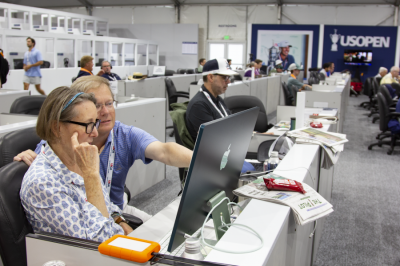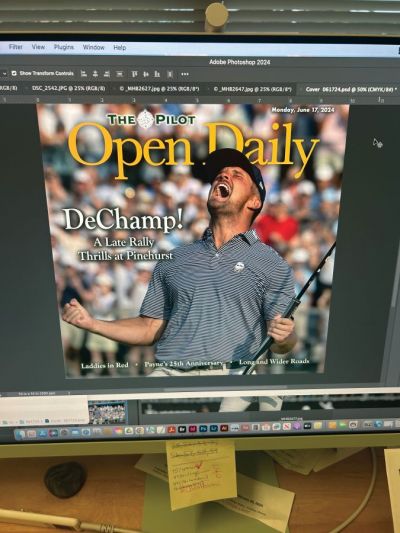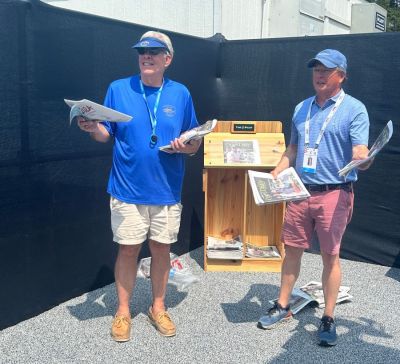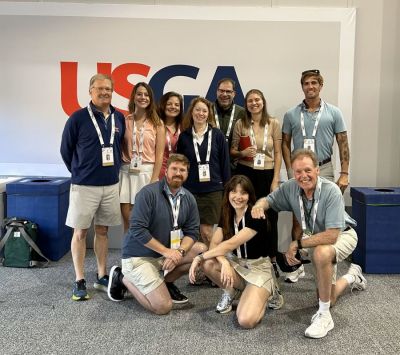Covering golf like a champ
Teri Saylor
Special to Publishers' Auxiliary
Aug 1, 2024




If you’ve ever talked about newspapers with North Carolina publisher David Woronoff, you’ve likely heard his motto: “We’ll always be a small-town newspaper, but we'll never be small time.”
That slogan rang true during the USGA’s 124th Annual U.S. Open Golf Championship in Pinehurst last June when Woronoff and his entire team at The Pilot of Southern Pines went beyond the call of duty to add the Open Daily newspaper to its regular twice-weekly publication schedule.
“We printed five editions of Open Daily distributed around the golf course and at every local hotel and breakfast restaurant, three broadsheet photography sections as part of our regular twice weekly newspaper, a 188-page edition of our monthly magazine PineStraw and eight Open Daily email newsletters distributed to 100,000 people across North Carolina,” Woronoff said.
Some might view this scheme as madness, but for Woronoff and his fellow Pilot owners, it was madness only the first time they tried it in 1999, when the Championship made its inaugural visit to Pinehurst, one of the communities The Pilot covers.
The U.S. Open Golf Championship is among the largest and most star-studded sporting extravaganzas in the world, attracting golf’s elite and bringing hundreds of thousands of spectators, vendors, sponsors and volunteers to the week-long event.
Woronoff quickly realized his entire coverage area would be swallowed up in the enormity of it.
“The Pilot only comes out twice a week,” he said. “We couldn’t cover the magnitude of the event in two editions, and we were not going to miss a great opportunity,” he said.
Despite its size and scope, Woronoff, viewed the U.S. Open as tailor-made for an intensely local community newspaper.
“Our editorial content is close to 100% local, produced either by staff or someone in our community,” he said. “We have always considered the U.S. Open a local story because it happens here.”
The 8,500-circulation newspaper has been locally owned and circulated in Moore County for 104 years, founded in 1920 by Stacy Brewer in the small town of Vass. The original building is still standing, and according to town history, now houses the Vass Barber Shop.
In 1941, The newspaper moved to its current location in Southern Pines. Over the years, the Pilot changed hands numerous times until Woronoff and four partners: Jack Andrews, Lee Dirks, Frank Daniels III and his father, the late Frank Daniels Jr., bought the newspaper from Sam Ragan 28 years ago. Woronoff’s corner office is next to the building’s front door with a picture window overlooking the street. Visitors are welcome, and he often greets them himself.
At the height of production under its current owners, The Pilot’s circulation was around 15,000, nearly double what it is today, Woronoff said. But over the last three decades, the business has diversified, adding five magazines across the state, a variety of online publications and newsletters, a full-service digital marketing agency, its streaming Pilot Radio channel, and a local bookstore right down the street from the newspaper’s office. In 2011, the group sold its press and began outsourcing the printing.
In 1999, Woronoff was 34 years old and had been the publisher of The Pilot for three years when the U.S. Open Golf Championship first came to town.
“Go big or go home” comes to mind when imagining how Woronoff contemplated covering one of the world’s greatest sporting events in a small community, over 50 miles from the amenities of the closest large city. He accompanied a delegation of Moore County officials to observe the 1998 U.S. Men’s Open at the Olympic Club near San Francisco and came home with a business plan.
“We pride ourselves on being entrepreneurial, and we want to be more than just a newspaper, so I asked myself, ‘Why don’t we create a pop-up community newspaper for the U.S. Open?’” he said. “We set a goal to sell a month’s worth of ad revenue in the one week of the championship.”
The sales team met the challenge that first year and has hit that goal every year since.
The Open Daily is a 64-page tabloid and includes 32 pages of ads. The press run is 5,000 distributed free. Woronoff’s only regret is that the print copies were depleted early each day.
LOGISTICAL CHALLENGES
One of the newspaper’s biggest challenges that first year was figuring out the logistics of reporting, photographing, editing, designing, printing and distributing a week’s worth of daily newspapers when The Pilot staff would typically produce three per week. (The newspaper converted to twice weekly in 2013.)
So Woronoff recruited friends and colleagues including local sports journalists, North Carolina newspaper publishers and journalism professors as volunteers to take on all aspects of putting out the Open Daily. He also recruited top golf writers and sports photographers from around the country and convinced them to drop what they were doing to spend a week producing the special edition.
Brownie Futrell, then the publisher of the Pulitzer Prize winning Washington (North Carolina) Daily News, handled distribution, trucking stacks of newspapers to various venues in the community and hawking them during the championship. Twenty-five years later, Futrell, who is retired from the newspaper business, is still filling that role.
“I was the Tom Sawyer of newspapering,” Woronoff quipped.
Today, he doesn’t need a hard sell. Veteran writers are eager to spend a week in the media tent and in The Pilot’s small newsroom working alongside the newspaper’s 25 employees — journalists, ad salespeople and designers.
ADVERTISING KEY TO SUCCESS
The Open Daily’s ads, sold in a modular format well in advance of the event, were key to its success as a viable product. Woronoff credits his sales team and the relationships they’ve built in the community.
“We’ve got a talented sales staff, and our customers know we put out a quality product,” Woronoff said. “When they see the lineup of writers we’ve recruited to cover the event, they want to be a part of it.”
Virtually all our advertisers are local businesses, said ad director Ginny Trigg, who added that all were excited about partnering with the newspaper.
“This is like the Super Bowl for us,” she said.
Trigg’s sales staff started selling ads at the end of the summer in 2023, almost a year in advance of the Championship.
“We started around the August and September time–frame because we wanted to make sure we were getting in front of people whose fiscal year and budgets needed to be in place by fall, and for some of them, it was a large ask,” she said. “Most of the advertising came last spring, in advance of the Championship.”
Trigg and her team bundled advertising packages, using total audience reach, touching the newspaper’s readers in three different vehicles — the print and digital product and daily emails that went to 100,000 addresses gleaned from the email lists of all The Pilot’s products. The newspaper dropped the paywall so the public could read the coverage and the ads for free.
“Our local businesses supported the Open Daily in a big way,” she said.
JOURNALIST’S DREAM
In the newsroom a week after the Championship, editor John Nagy was still feeling lingering remnants of his adrenaline rush from editing The Pilot’s regular edition and the Open Daily on deadline.
“We were first and foremost a digital product,” he said. “We fed the news beast all day long and ended up with something like 87 stories and 24 or 25 photo galleries over the course of that week,” he said. “This means we averaged 10 robust online stories a day, which is just a huge amount of copy for any operation.”
Only a fraction of the stories made it into the print editions, he added.
“I stayed in the USGA media center, pretty much acting as the conduit between the print and digital worlds, so part of my job was editing everything that came in and pumping it online,” Nagy said.
The page designer worked alongside Nagy at the media center, laying out pages on the fly. Because they had a 9 p.m. print deadline, they couldn’t wait until the final putt dropped to start production.
Both Nagy and Woronoff are especially proud of their team of young reporters, who admitted they could never imagine what it would be like to cover such an important event and learned a lesson in the value of community journalism.
Emilee Phillips, a staff writer for The Pilot who also creates social media content and writes for one of The Pilot’s regular newsletters, focused on covering the fan experience at the U.S. Open and reporting on how life revolved around golf in the community.
One of her favorite stories was about a woman whose passion is making cheese carvings. She visited a local grocery store and carved a golf cart and a trophy out of two giant blocks of cheese.
“Every business here was trying to do something to support the Championship, to kind of get into the whole feel and spirit of it,” Phillips said. “And we covered it all.”
Elena Marsh, The Pilot’s local government reporter, focused on feature stories about the Championship for the regular newspaper and contributed to social media. She loves the variety in her job, and covering the U.S. Open is just one example.
“Working at the newspaper makes you feel part of the community in several ways,” she said. “You're living here, you're writing about life here, and people care about what you do.”
Pilot staff writer Ana Risano focused on stories surrounding the U.S. Open, including the special Amtrak train commissioned to move golf fans from Raleigh to Pinehurst, reactions from local businesses and stories from among the event’s 4,000 volunteers.
“It was so much fun to speak with both those who had been coming back to volunteer for years and those who were there for the first time,” she said.
Frank Daniels IV, executive producer for The Pilot’s radio channel, captured audio stories from the golf course. He enjoyed hanging out in the media center.
“I'd say for me, the biggest takeaway was the feeling that all eyes were on Pinehurst,” he said. “And in turn, all eyes were on us because we were really at the heart of it.”
Nagy and Woronoff made sure the entire staff had press passes, turning the young reporters’ work into a learning experience.
“We had 300-400 international journalists coming to our town, and we’ve got rookie reporters in their 20s covering the biggest news event they’ve ever experienced,” Woronoff said. “We wanted them to have a front row seat and learn from this experience.”
In 2029, both the men’s and women’s U.S. Open Golf Championships will be back at Pinehurst, played back-to-back over a two-week period. Woronoff plans to get the band back together but admits by then he will be 65 and not getting any younger.
But in the end, he’s counting on passion to win out over exhaustion.
“If you find joy in what you do and you bring that joy, particularly in a creative endeavor like a newspaper, people are attracted to that, and they want to be a part of it,” he said. “We bring that to our work every day, and we try to find the fun in a job that has to be done.”
Teri Saylor is a writer in Raleigh, N.C. In 2001 and 2005, Teri Saylor joined volunteer teams of writers and photographers at The Pilot covering the U.S. Open Women’s Championship and The U.S. Men’s Championship. The technology has changed, but the can-do attitude and spirit of camaraderie remain. Contact her at terisaylor@hotmail.com










